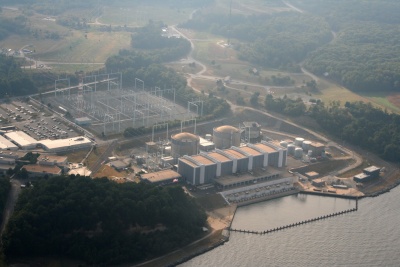
The Calvert Cliffs Nuclear Power plant as seen from the air Oct. 8, 2005. (Photo courtesy of wikipedia.org. Reprinted in accordance with GNU Free Documentation License)
LUSBY, Md. (Dec. 4, 2007)—U.S. Senator Benjamin L. Cardin (D-MD), yesterday met with Calvert County officials and toured the Calvert Cliffs Nuclear Power plant to learn more about plans to build a third nuclear reactor at the facility.
Senator Cardin, a member of the Senate Environment and Public Works Committee, says he is a strong advocate of the United States becoming energy independent by conserving energy and developing alternative energy sources to fossil fuels.
Cardin is an original co-sponsor of the Lieberman-Warner Climate Security Act, S. 2191, which will reduce greenhouse gas emissions in the United States by 70% by 2050. The bill is scheduled for committee action on Wednesday. The legislation will help America become more energy efficient, and provide bold new incentives for renewable energy sources while moving us away from traditional coal-fired plants.
Cardin also has proposed creating a bipartisan, Blue Ribbon Commission to study and review policy changes that are needed for the United States to achieve energy independence. The Commission would meet every two years and report to Congress on how to adjust policies to achieve energy independence by 2017. Energy independence is defined as getting 90% of our energy needs from domestic sources.
“Nuclear power needs to be a part of our energy strategy in helping us achieve energy independence and in fighting global warming,” said Senator Cardin. “However, any new facility would have to ensure the safety of our communities and the environment.” He also pointed out that Maryland’s coastal areas are particularly vulnerable to flooding and to the effects of global warming.
Constellation Energy and its partner UniStar are hoping to construct a third reactor at Calvert Cliffs. The extensive approval process by state and federal regulatory agencies is expected to take two years. Currently, Calvert Cliffs operates two reactors, supplying 26.2% of the electricity generated in Maryland. A third reactor is expected to almost double Calvert Cliffs’ energy-producing capacity.
There has been some local opposition to the proposed expansion at Calvert Cliffs. Critics point to the bottleneck on one of the key evacuation routes--the two-lane Johnson bridge that connects Calvert County to St. Mary's County. The State Highway Administration (SHA) estimates that it will take approximately nine years to construct a new companion bridge.
The Calvert County Commissioners are overwhelmingly in favor of the expansion. The local government benefits greatly from taxes and fees paid by the utility. The windfall of revenue handsomely pads the government coffers and isolates the Calvert County politicians from constituent and taxpayer outrage that affects their counterparts in other counties where there are budget shortfalls.
But, while the Calvert County taxpayers benefit from the presence of a nuclear power facility, the federal taxpayers foot the bill for many government subsidies for the nuclear power industry.
The federal government provides billions of dollars in loan guarantees to the industry. The risk of default on loan guarantees for new nuclear plants is "very high – well above 50 percent," according to a May 2003 Congressional Budget Office report. Thus, the so-called "free market" corporate lenders are unlikely to loan money without government guarantees.
Federal taxpayers also subsidize some of the cost of insurance for the nuclear industry. The Price-Anderson Act limits the industry’s liability to the public in the event of a nuclear accident. The Act establishes a no fault insurance-type system in which the first $10 billion is industry-funded. Any claims above the $10 billion would be covered by the federal government.
Federal taxpayers also foot much of the bill for related national security issues and disposal and storage of the highly dangerous nuclear waste.


